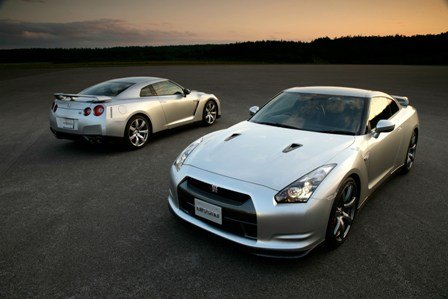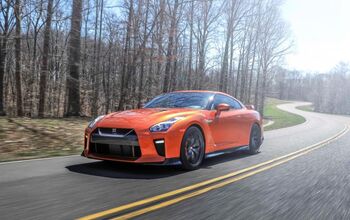Nissan GT-R: What Price New Hotness?
In Michelangelo Antonioni's film "Blow Up," Thomas (David Hemming) watches a rock guitarist smash his ax and toss the remnants into the audience. Caught up in the spirit of the moment, Thomas joins the scrum scrambling for a piece of the dead guitar. He grabs the lion's share and runs away. Dozens of fans give chase, attempting to wrest the prize from his grasp. Finally, Thomas is clear of the crowd. Alone with his treasure, he contemplates his booty– and then casually tosses it into a nearby trash can. Nissan GTR anyone?
Sacrilege! The new Nissan GT-R blasts from zero to 60mph in 3.5 seconds, navigates the Nürburgring as fast as the Porsche 911 Turbo and (allegedly) does so with more confidence than Stuttgart's finest. All this with a Manufacturer's Suggested Retail Price (MSRP) starting just under $70k. Clearly, it's the performance automotive bargain of the decade.
On the day the initial U.S. dealer allocations of GT-Rs were announced, the mathematics made the problem clear. Nissan deemed exactly 691 dealers "qualified" (i.e. large and financially productive enough) to sell the GT-R. During the model's inaugural year, Nissan will build 2500 GT-Rs worldwide, only 1400 vehicles of which will make it stateside.
It doesn't take long to divide 1400 by 691 and conclude that the anointed U.S. Nissan dealers will receive two GT-Rs (on average). Since these dealers were obliged to make an investment in the equipment needed to service the GT-R's unique run flat tires, it makes sense that they'd want to recoup that investment ASAP, over the two model transactions they'll experience in 2008. And, lest we forget, they're car dealers.
Bottom line: a "buyer's premium."
So when I contacted my local dealer to place an order for my very own Nissan GT-R, I wasn't surprised to encounter a lot of squirming and shadow puppeteering. This, of course, gave me a reverse Groucho Marx; I wanted to join a club that didn't want me as a member. BUT–
I am allergic to paying more than MSRP for anything (I have a doctor's note to prove it). The idea of forking over a significant premium for a GT-R in its first year of release makes me feel both elated and stupid.
To delete "stupid" from this equation, I began an on-line investigation, hoping to tap the experiences of other enthusiasts desperately seeking a Nissan GT-R. Most of the stories I encountered indicated that dealers were adding a $10k to $25k additional onto the car's MSRP.
About a half dozen commentators listed dealers committed to selling their GT-Rs at MSRP. This information did me little good, as one sale accounted for half of their allocation. By the time I'd identified the virtuous dealer their other GT-R was also sold. Living in California didn't help; the Golden State's love for fast cars seems to blur the lines of whatever rational decision-making may remain within state borders.
Of course, the upshot of this hot model fever is a four-wheeled Ponzi scheme. Aside from the Ferrari Enzo, you can count on one hand the number of cars that garnered a premium from the onset, and maintained that value (and you'd still have enough fingers left to make gang signs). Anyone remember the $100k dealers placed on top of the dreadful BMW Z8? The SL55 AMG for $50k on top? And yes, people paid above the odds for a Pontiac Solstice.
Eventually, as the hot model cools, someone gets burned. IF you're going to pay a premium for a hot car, the "trick" is to do so straight out of the chute, then sell the car before availability catches-up with demand. Given that the Nissan GT-R ain't no Ferrari, and Nissan dealers love money, I reckon Nissan will up production after the 2008 model year, big style. At that point, the premium will disappear, for both buyer and seller.
You want to talk about killer depreciation? Then you need to contemplate the concept of "front loading" an asset destined to shed value. A 2005 SL55 AMG with less than 20k on the clock can now be yours for $86k as a certified pre-owned car from an MB dealer- and a lot less as a private purchase. With Solsti piling-up on dealer lots, there isn't a single soul in the U.S. who'll pay you above the odds for a new one. Not one.
So I'm hot on this quest to find someone who will accept my order for a Nissan GTR at MSRP and I've never even seen one in person– let alone felt the driving experience. Two questions. How long will the hype last? With all this demand and little supply, how long will there be someone willing to pluck this discard from my trash heap and pay ME more than MSRP for the privilege? Second, would I even like it?
More by Jay Shoemaker
Latest Car Reviews
Read moreLatest Product Reviews
Read moreRecent Comments
- Honda1 Unions were needed back in the early days, not needed know. There are plenty of rules and regulations and government agencies that keep companies in line. It's just a money grad and nothing more. Fain is a punk!
- 1995 SC If the necessary number of employees vote to unionize then yes, they should be unionized. That's how it works.
- Sobhuza Trooper That Dave Thomas fella sounds like the kind of twit who is oh-so-quick to tell us how easy and fun the bus is for any and all of your personal transportation needs. The time to get to and from the bus stop is never a concern. The time waiting for the bus is never a concern. The time waiting for a connection (if there is one) is never a concern. The weather is never a concern. Whatever you might be carrying or intend to purchase is never a concern. Nope, Boo Cars! Yeah Buses! Buses rule!Needless to say, these twits don't actual take the damn bus.
- MaintenanceCosts Nobody here seems to acknowledge that there are multiple use cases for cars.Some people spend all their time driving all over the country and need every mile and minute of time savings. ICE cars are better for them right now.Some people only drive locally and fly when they travel. For them, there's probably a range number that works, and they don't really need more. For the uses for which we use our EV, that would be around 150 miles. The other thing about a low range requirement is it can make 120V charging viable. If you don't drive more than an average of about 40 miles/day, you can probably get enough electrons through a wall outlet. We spent over two years charging our Bolt only through 120V, while our house was getting rebuilt, and never had an issue.Those are extremes. There are all sorts of use cases in between, which probably represent the majority of drivers. For some users, what's needed is more range. But I think for most users, what's needed is better charging. Retrofit apartment garages like Tim's with 240V outlets at every spot. Install more L3 chargers in supermarket parking lots and alongside gas stations. Make chargers that work like Tesla Superchargers as ubiquitous as gas stations, and EV charging will not be an issue for most users.
- MaintenanceCosts I don't have an opinion on whether any one plant unionizing is the right answer, but the employees sure need to have the right to organize. Unions or the credible threat of unionization are the only thing, history has proven, that can keep employers honest. Without it, we've seen over and over, the employers have complete power over the workers and feel free to exploit the workers however they see fit. (And don't tell me "oh, the workers can just leave" - in an oligopolistic industry, working conditions quickly converge, and there's not another employer right around the corner.)































Comments
Join the conversation
The guitarist was Jimmy Page and also on stage was Jeff Beck. It was the last incarnation of the Yardbirds before they morphed into Led Zeppelin. Oh Yes. About the car? I dunno
[...] Source: http://www.thetruthaboutcars.com/2008/02/unobtainable-at-msrp/ [...]